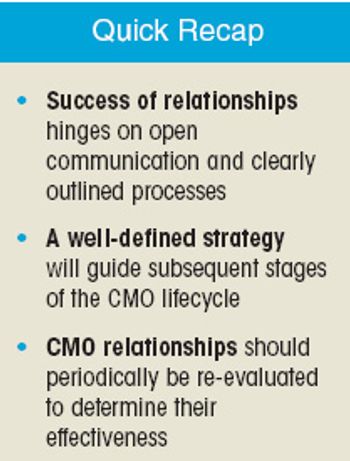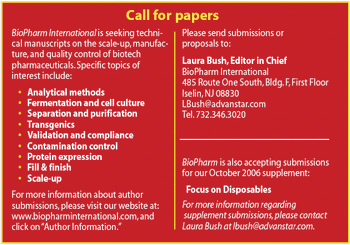
Congress is not considering legislation that would expand FDA authority to regulate biologics.

Congress is not considering legislation that would expand FDA authority to regulate biologics.

Many CMO relationships are established while a product is early in clinical or preclinical development.

Buffett prefers to buy small, publicly traded companies with ample room for growth.

Food and Drug Administration is encouraging public–private collaborations to more fully explore the physical and chemical characteristics of nanoparticles.

The lack of biomanufacturer acquisitions seems surprising.

The courts regard biotechnology as highly unpredictable

Without generic competition, the US is at risk of losing its position of leadership in biopharmaceuticals.

Disposables can be used for media preparation, clarification, filling in downstream processes . . .

The top 10 Chinese companies in the biopharm sector account for only 20% of the market... leaving plenty of room for growth for Western companies.

Motorola recognized that vartion is the death knell of any process, so the company established a methodology called Six Sigma

Certain areas of the vaccine market appear to be in vogue again, revitalized by blockbusters such as Prevnar, the pneumococcal pneumonia vaccine that reaped $1.5 billion in sales last year, and the human papilloma virus vaccines, which are projected to reach $4 billion per year.

Only the product that served as the basis of the extension is exclusively covered by the patent during its extended term.

The federal government plans to spend $3.3 billion on bird flu initiatives, about half of that on a vaccine.

Coming from Wall Street. I'm often asked what "professional" investors think about the life sciences industry.

Interestingly, it is companies that already have the most capacity available to them that are building even more.

Of all the protein products on the US market, at most 75 are likely to become genericized.

A powerful film will have a hundred times the impact of a touchy-feely commercial.

Minimum disruption and maximum gain result when adopting a distributed process control and data management system for a cell culture and fermentation lab.

Australia's pharmaceutical industry as a whole turns over approximately US$10.7 billion a year and spends some US$384 million annually on research and development.

The above statement reflects the opinion of a growing number of US governors and key state lawmakers.

. . . Popular consortium meetings have focused on successful use of tools to drive improvement in cycle time reduction, deviation reduction, and improved production efficiency.

Like a snowball rolling down Mt. Everest, stem- cell research was gaining momentum, not only in political and medical arenas, but on Wall Street, too.

On June 13, 2005, in Merck KgaA v. Integra Lifesciences I, Ltd., the US Supreme Court ruled unanimously that the exemption to patent infringement outlined in Title 35, Section 271(e)(1) of the US Code extends to all uses of patented inventions reasonably related to the development and submission of any information under the Food, Drug, and Cosmetic Act, including preclinical studies. In practice, this means that the exemption will allow companies to use other firms' patented compounds for experimentation on drugs that are not ultimately the subject of a submission to the Food and Drug Administration.

These latest pressures on technology relate not only to the need for improved manufacturing productivity and shorter development times, but also to the need to create smarter manufacturing operations

How much of an impact does patent reform, real or imagined, have on biopharmaceutical stocks?